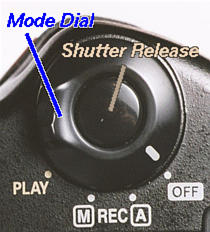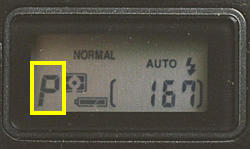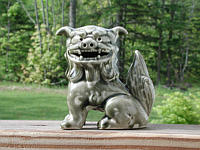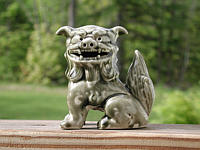The Aperture-Priority Mode

Introduction
Under the aperture-priority mode, you select an aperture and the camera
chooses an appropriate shutter speed. The main purpose of using
aperture-priority mode is to control the
Depth of Field.
An aperture value is written in a form of Fx.y.
The larger the F value the smaller/narrower the
lens opening. For example, an aperture value
F5.6 has a smaller lens opening than that of F2.8.
For each focal length, Coolpix 950 provides you with only
three possible aperture values.
The following table shows the available aperture values of three focal lengths.
Thus, if you use the shortest focal length (i.e., 38mm), you can only
use F2.6, F4.4, or F7.4. Comparing with a 35mm SLR camera, this list of
choices is too short.
Focal Length
35mm Equivalent |
Possible Aperture Values |
| 38mm |
F2.6, F4.4, F7.4 |
| 75mm |
F3.1, F5.2, F8.7 |
| 115mm |
F4.0, F6.8, F11.4 |
Selecting the Aperture-Priority Mode
To use the aperture-priority mode, the first step is to enter the
M-REC mode by turning
the mode dial to M-REC.
 The Mode Dial and Shutter Release Button
The Mode Dial and Shutter Release Button
Now we are in the manual mode. The next step is to select the
aperture-priority mode. To do so, hold the
MODE button
(below left) while turning the command dial (below right).
 |
 |
|
The MODE Button
|
The Command Dial
|
When turning the command dial, the letter in the lower-left corner of the
control panel and the LCD monitor will change (see the figure below).
The possible letters are
P,
A and
S for
program mode, aperture-priority mode, and shutter-priority mode, respectively.
Therefore, once A
appears, the camera is in aperture-priority mode. Once the camera is in the
aperture-priority mode, you can release the
MODE button.

You can use the same procedure to go back to the program mode.
Selecting an Aperture
When the camera is in the aperture-priority mode, turning the command dial
selects an aperture. As the command dial is being turned, an aperture value
in the form of Fx.y appears on the LCD monitor and
on the control panel replacing the number in the bracket. Once the desired
aperture appears, stop turning the command dial and the camera will use that
aperture value for the next exposure. The corresponding shutter speed
also appears on the LCD monitor so that you can determine if the aperture and
shutter speed combination is an appropriate one. If you are satisfied with the
combination, release the shutter to take a photograph; otherwise, turn the
command dial for a new aperture setting. If the camera
is in the aperture-priority mode and turning the command dial does not cause the
aperture to change, press the MODE button again and
turn the command dial.
Why the Aperture-Priority Mode?
The use of aperture-priority mode is basically for controlling
Depth of Field. The larger the
aperture, the shallower the depth of field. A shallow depth of field makes
the main subjects standing out. The following images were taken by zooming
all the way in (i.e., focal length 115mm, 35mm equivalent).
The aperture values used were F11.4 (smallest aperture), F6.8, and
F4.0 (largest aperture). The sharpness of the left image, from foreground to
background, does not change very much. As the aperture becomes larger,
foreground and background start to blur. In the right image below, which
was taken using F4.0, the background becomes reasonably blurred so that the
yellow flow in the middle is isolated from the background. Note also that
the flowers in the foreground are also blurred. Therefore, when you need to
isolate your subjects from the background/foreground such as a portrait shot,
use larger aperture.

|

|

|
|
F11.4
|
F6.8
|
F4.0
|
|
Click on the icon to see a larger image
|
The following images show another example of the relationship between depth of
field and aperture.

|

|

|
|
F10.7
|
F5.4
|
F3.9
|
|
Click on the icon to see a larger image
|




